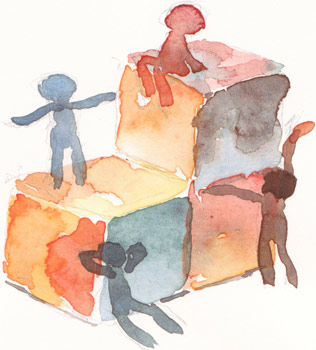Block Building
Directed block
building is an effective way to retrieve and reinforce a field trip. Build the
fire house, the park, zoo, or your whole city.
Objectives
Children ages 5-6 years will be able to construct a
3-Dimensional model with blocks the represent actual structures in the
environment Cog. IV A
and they will be able to share blocks and work cooperatively in building SE VI
Children ages 4-6 can name structure in relationship to the function of the
building. Cog. IV A
and children ages 3-4 can use classification of materials such as people,
animals, transportation, size, and shape of blocks. Cog. IIIA
All children participating will be able to put blocks and accessories away in
proper place. SE V
Materials
Block corner; set of
unit blocks, large wooden or Styrofoam blocks, accessories to include:
transportation toys (cars, trucks, boats, planes, fire engines, etc.); simple
wooden or rubber people and animals (zoo, farm, domestic); miscellaneous
colored cubes; large dominos; parquetry blocks; samples of tiles; linoleum
square; carpet scraps; lumber scraps; shells; popsicle sticks; strips of paper
for making signs; felt pen; tape; magazine pictures of buildings; bridges, etc.
Procedures
1. Choose a protected
area removed from the main traffic of room. Mark off the area on the floor into
city blocks with masking tape. Be sure to put a strip of tape on floor about 1’
out from block storage area to remind children not to build too close to the
shelves. Paste magazine pictures of bridges, roads, buildings, parks, etc. on
walls around block area for ideas and inspiration. Be certain to allow
sufficient time for building and clean-up.
2. The teacher’s attitude towards block building will greatly influence the
quality of the children’s building. Talk about what we find in a city: parks,
roads, houses, apartments, etc.
3. Have children work in small groups of 2-3. Have each group choose a taped
off area to build in and decide what they want to construct. As children build,
stay with them to facilitate language, offer suggestions, and give recognition
for skill, imagination, perseverance, and cooperative work. Be available to
help make signs for their structures. Step into a situation when it becomes
clear that the children cannot solve a problem (technical or social) for
themselves.
4. Give ample warning to children for clean-up— "5 more minutes…2 more minutes" —before clean-up. Be certain you have acknowledged the children’s buildings
before they are taken down. Encourage them to tell you about their building.
Take photos of the constructions to display in the block area. Organize
clean-up by assigning specific jobs to different children, e.g. put away blocks
of specific shapes or size, by number of blocks to be picked up, or by
accessories. 
Variation: As a group, build
one large, tall structure using all
available blocks. Then carefully tie
strings on blocks, letting each child choose where they want the string
attached. Each child holds the end of a string. Count down On the signal,
everyone pulls at once. Repeat building or start clean-up.
Or,
tie long strings on four or five blocks beforehand; use these blocks as the
foundation for the skyscraper. Build
then pull strings.
|